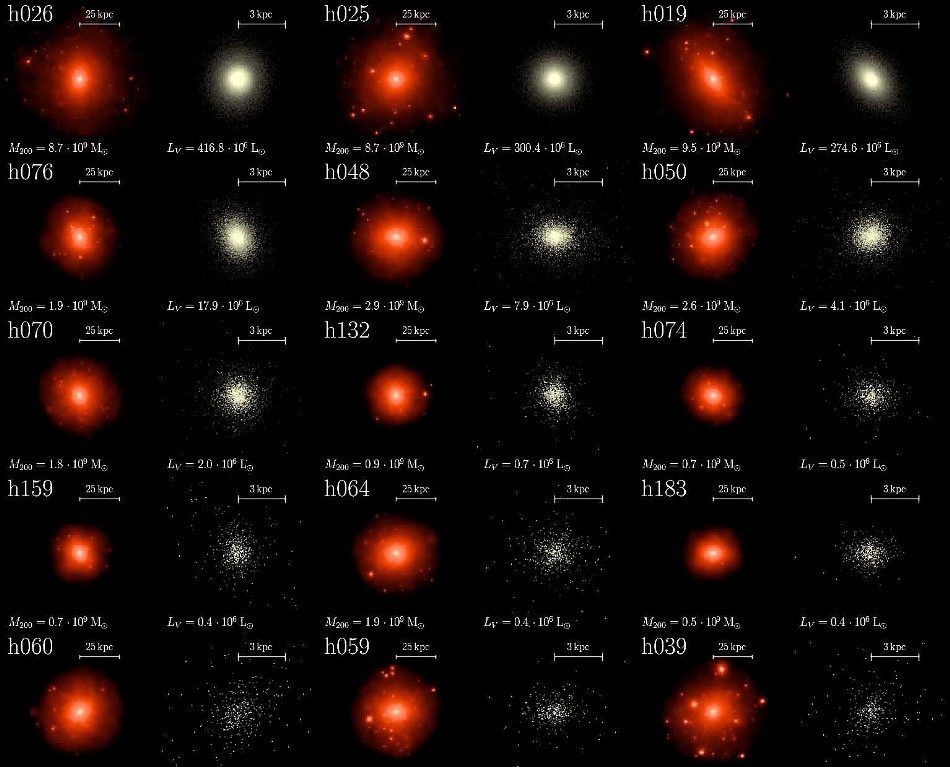Apr 24 2018
Researchers at EPFL have finished the difficult task of studying 27 dwarf galaxies in detail, classifying the conditions under which they were created and how they have since evolved. These minor galaxies are ideal for investigating the mechanisms of new star formation and the very first steps in the formation of the universe.
 Catalog of the studied dwarf galaxies' haloes. (Image credit: © 2018 EPFL/LASTRO)
Catalog of the studied dwarf galaxies' haloes. (Image credit: © 2018 EPFL/LASTRO)
Dwarf galaxies do not produce much light and so are hard to observe, but they have plenty to teach us about how the universe was formed. Scientists from EPFL’s Laboratory of Astrophysics (LASTRO) fastidiously studied 27 such galaxies and discovered an astonishing degree of variation in the mechanisms by which their stars were created. The results of their thorough study were reported in Astronomy & Astrophysics.
Dwarf galaxies are the smallest and probably the oldest galaxies in the universe. Under standard cosmology theory, larger galaxies are formed by the merger of these smaller ones
Yves Revaz, Galaxy Dynamics Expert at LASTRO
While they may be referred to as “dwarves,” they are actually huge and can weigh anywhere between hundreds of thousands and several million times as much as the sun. They are also the galaxies where the most dark matter can be found. The LASTRO team thus had to develop very advanced computer models to explore these galaxies’ size, properties, and temporality – all of which go well beyond man’s basic understanding.
Their models take into consideration each of the galaxies’ components—–stars, gases, and dark matter—as well as the relationship between dark matter and visible matter (known as “baryonic matter” in astrophysics). The models also take into account the conditions under which matter was formed when the universe first came into being some 14 billion years ago – conditions that are at present known as a result of recent space missions undertaken to discover the signatures of the Big Bang.
Step by Step
To test the dwarf galaxies, the researchers first took each model and went one step at a time through the galaxies’ main features like how much gas (mostly hydrogen) they contain, the heating and cooling of their interstellar mediums, their compression and expansion processes, the consecutive generations of their stars, those stars’ supernovae, and the ensuing discharge of a range of chemicals. The researchers then compared the results of their models with data that had been attained by studying dwarf galaxies—more precisely, those orbiting man’s galaxy, the Milky Way, and its neighboring galaxy, Andromeda (M31)—using eight-meter optical telescopes, the biggest that are presently out there. These dwarf galaxies form part of what is known as the Local Group and are sufficiently close for astrophysicists to be able to acquire accurate information on the chemical components and ages of different stars.
Ensuring that the models’ results match empirical data is vital if the researchers want to apply them to investigate their theories about dark matter, the kinds of objects accountable for the re-ionization of the universe, and the time periods and conditions for the birth of a new star.
This is the first time that dwarf galaxies have been scrutinized in such detail and under cosmologic conditions – that is, not by considering them as secluded systems but instead by taking into consideration all the interactions among the very first galactical systems.
Excellent Guinea Pigs
“The advantage of dwarf galaxies is that they respond very well to even minor changes in conditions, making them excellent guinea pigs for studying galaxies in general,” says Pascale Jablonka, a LASTRO researcher specialized in spectroscopy and galaxies’ chemical development and the study’s co-author. For example, by examining the light that stars produce, she was able to establish their chemical composition and how long it took them to develop.
Our models enabled us to create a database of many different types of stellar activity and gave us valuable insight into the factors that can cause star formation to speed up, slow down or even stop altogether.
Yves Revaz, Galaxy Dynamics Expert at LASTRO
According to the data they gathered—which includes a remarkable number of different star-formation mechanisms given how “small” dwarf galaxies are—the LASTRO team discovered that the particular mechanism used relies on the density of the galaxy’s baryonic and dark matter. That density establishes whether a galaxy will keep on forming stars or abruptly stop. If a dwarf galaxy’s matter is highly dispersed, then its hydrogen will get very hot and evaporate, meaning it cannot form stars anymore. If, on the other hand, a dwarf galaxy has a thick halo of dark matter shielding it, then star formation will continue swiftly.
Dwarf galaxy simulation